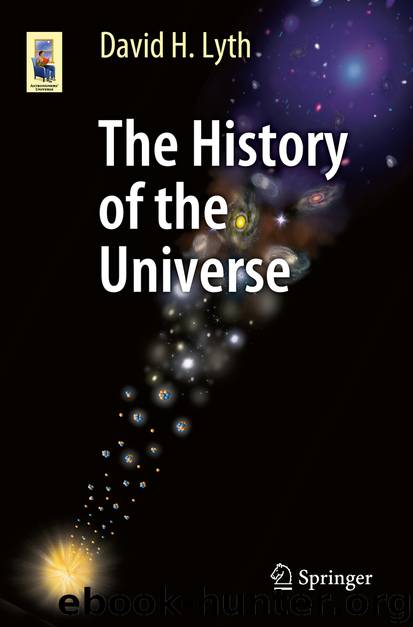The History of the Universe by David H. Lyth

Author:David H. Lyth
Language: eng
Format: epub
Publisher: Springer International Publishing, Cham
I will take the radius of the smoothing sphere to be proportional to the scale factor a, and will call its present value the smoothing scale . The smoothing scales that can be probed by observation range from the distance to the present horizon, which is 4. 5 × 1010 lightyears, down to about 104 lightyears. I will call them cosmological scales .
The Initial State
The known history of the Universe is determined by the state of affairs at the beginning. We have seen how that works for the homogeneous Universe, and now we are going to see how it works for the perturbations.
At the beginning of the known history, the smoothing radius is bigger than the distance to the horizon on all cosmological scales. The perturbation in the smoothed energy density existing then, is called the primordial energy density perturbation. One usually assumes that at this stage, the energy densities of the separate components are completely determined by the total energy density. This is called the adiabatic condition , and it is consistent with current observation. One can show that in consequence of the adiabatic condition, each component of the cosmic gas starts out with about the same density contrast.
We are not interested in the details of the density contrasts. In particular, we are not interested in the locations of the individual peaks of the CDM’s smoothed density contrast, that will become galaxies. The locations of individual galaxies are accidents, just as the distance of the Earth from the Sun is an accident. We interested instead, in the statistical properties of the density contrasts.
To understand what that means, let’s imagine that a coin is tossed many times, and the results are written down. Then we could highlight all the ‘heads’ entries, and see how they are distributed. On average there would be as many heads as tails, but the distribution would be uneven and we would sometimes find two heads together. We might find even three or more but that becomes increasingly unlikely. We could work out of the probability for each of these possibilities, and of any other possibility regarding the distribution of ‘heads’. Then we would be studying the statistical properties of the distribution of ‘heads’.
The statistical properties of the density contrasts refer to their form at a fixed epoch. They are described in some detail in Appendix A. It turns out that the statistical properties at the beginning of the known history are specified by two parameters, whose values are shown in Table A.8 of Appendix B. Here in the text, I will only be dealing with the most important statistical property, which is the average of the square of the CDM matter density contrast.1 This is called the mean-square because mean is another word for average.
Download
This site does not store any files on its server. We only index and link to content provided by other sites. Please contact the content providers to delete copyright contents if any and email us, we'll remove relevant links or contents immediately.
| Aeronautics & Astronautics | Astronomy |
| Astrophysics & Space Science | Comets, Meteors & Asteroids |
| Cosmology | Mars |
| Solar System | Star-Gazing |
| Telescopes | UFOs |
Tools of Titans by Timothy Ferriss(8215)
Turbulence by E. J. Noyes(7935)
Secrets of Antigravity Propulsion: Tesla, UFOs, and Classified Aerospace Technology by Ph.D. Paul A. Laviolette(5309)
Astrophysics for People in a Hurry by Neil DeGrasse Tyson(5130)
Room 212 by Kate Stewart(5035)
Design of Trajectory Optimization Approach for Space Maneuver Vehicle Skip Entry Problems by Runqi Chai & Al Savvaris & Antonios Tsourdos & Senchun Chai(5011)
Pale Blue Dot by Carl Sagan(4909)
The David Icke Guide to the Global Conspiracy (and how to end it) by David Icke(4624)
A Journey Through Divination and Astronomy by Publishing Pottermore(4343)
Goodbye Paradise(3726)
Apollo 8 by Jeffrey Kluger(3635)
COSMOS by Carl Sagan(3553)
Losing the Nobel Prize by Brian Keating(3498)
The Five People You Meet in Heaven by Mitch Albom(3474)
How to Read Water: Clues and Patterns from Puddles to the Sea (Natural Navigation) by Tristan Gooley(3406)
Brief Answers to the Big Questions by Stephen Hawking(3369)
How to Read Nature by Tristan Gooley(3249)
The Order of Time by Carlo Rovelli(3145)
A Brief History of Time by Stephen Hawking(2959)
